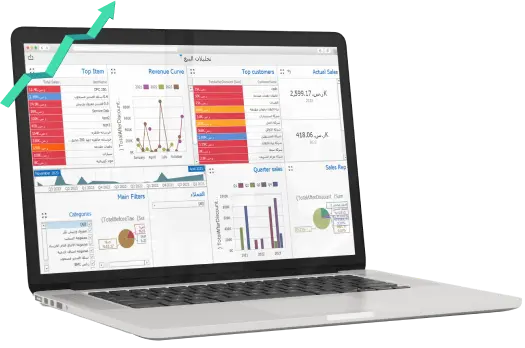Accounts tree (chart of accounts) if you like to control the work of the financial management of any company, the first thing you need to see is the chart of accounts.
If you are working on an accounts program, you need to create a tree of accounts, because you will not know to make an entry except when this account is in the account tree; and if you are working on a manual system on ledgers, then you need to work on the accounts which the restrictions are directed and do not create a new account with each Transaction without noticing.
Accounts tree is the first step in the design of any accounting system, whatever the complexity or the way in which the system is applied.
In this article, we can easily explain what a directory or account tree means, and how accounts are coded in the form of a branched and multi-level tree directory.
What is the tree of accounts?
The account tree is a disclosure or statement in which all the accounts that I deal with are written in it. We call it the chart of accounts because it is divided into main accounts and sub-accounts in a tree form
And we consider it as basic rule of my system in the first place by dividing the accounts in your account into financial position accounts, which are your assets, liabilities, and income statement accounts, which are the sources of the revenues items in you, as well as the items of expenses, and where your money goes exactly as we agreed that the division consists of main accounts branching out of sub-accounts, that we will see later
After you have defined your assets, liabilities, revenues and expenses, the code for these accounts begins, meaning that each account is distinguished by using it with a specific number and code of its own, and you are free in the form of this code.
Mostly the Asset element substitutes Code No. 1, and this is a major branch of the tree
Under it comes the fixed assets, for example, and we give it code 11, and this code means that this clause belongs to the assets, and the second 1 means that the first branch is under the assets.
If you have, for example, cars, which is the first clause in the fixed assets, we give it code 111, means that this clause belongs to the assets group, under the fixed assets branch and also the first item in the fixed assets
If you have machines, for example, you can give them this code 112, meaning that this clause is an original and belongs to the fixed assets in particular, and it is the second clause from the fixed assets clause.
Little focus also
If I have a lot of machines, this means that under the branch of machines, I will code every machine I have
So if there are two machines, for example, a cutting machine and a welding machine, I give the cutting machine this code 1121, which means that this clause belongs to the fixed assets and also under the machinery branch, which is the first item in machines. The welding machine has the code 1122. And so on you give in this way all the elements of your assets
We come to a second item, which is expenses, and for example, take the number 3, and under it I put all the elements of my expenses.
For example, we give general and administrative expenses number 31, this means that this clause is the first element of the expense, and under it we can put all the elements of the expenses that belong to the general and administrative expenses
If I give the number 311 to my wages, which means that this element belongs to the expenses under the administrative expenses
It is also the first clause in administrative expenses, and it is called wages. For example, if these wages were divided according to the departments in this case we make an account for each type of these wages and every account has a specific code. (All kinds of expenses and revenues are done in this manner as well)
What is the benefit of the chart of accounts or if I code my accounts and divide them in this way, whether Manuel or in an accounting program?
• First, we must know that creating a global account tree for all your accounts is the cornerstone of your system, especially if you are using an accounting program such as the General Accounting program, because all the work of this program is based on the accounts tree and there is no possible restriction that can be set up and directed, whether Manuel or Excel or In the general accounts program, unless these accounts are already exist.
• The process of designing the account tree in itself requires a very large effort from the financial team. At the beginning, but later on, it will be easy to add any new account or delete an old account
• In order to be able to make an accounting entry, the accounts in which I will throw the entries must be present primarily in the directory. If not, we must do it.
.• Division of accounts in itself will comfort me as an accountant because I can know the system of each account, so if I want to know, for example, how much are the employees ’wages, I can know that in a second. And if I want to know the wages of the employees of the Marketing Department only, I can know and all kinds of expenses will be in the same manner.
What are the levels of the accounting manual?
The accounting guide in any accounting system is a set of basic levels and sub-levels that must be available in the accounts program
Level one
Assets - Liabilities - Equity - Expenses – Revenues
This level is the basic level that must be available in any chart of accounts
Second Level
This level consists of dividing each of the five basic items into levels
It's mean:
Assets are divided into non-current & current assets
Liabilities fall into non-current & current liabilities
Equity is divided into equity, reserves, and retained earnings
Expenses are divided into administrative expenses & selling expenses & marketing expenses
Revenue is divided into company sales revenue & various revenue
The third level
It is the division of each of the previous clauses in the second level into a group of clauses
Non-current assets are divided into long-term (fixed) assets & intangible assets & investments
Current assets are divided into all kinds of cash & customers & inventory & other debits & credits
Non-current liabilities - divided into long-term loans & long-term provisions & deferred tax liabilities
Current liabilities are divided into Suppliers & Short Term Loans & Provisions & Other Credits
Shareholder rights - Capital is divided into paid up capital
Shareholders' rights- Reserves divided into statutory reserve & general reserve & other reserves
Administrative expenses - any administration expense - salaries & rent & transportation & buffet & ****** etc.
Selling expenses i.e. marketing expenses - salaries, commissions & transfers, exhibition rent & ***** etc...
Operating expenses i.e. expenses related to the production and the factory salaries & fuel & oils & electricity of the factory & **** etc...
Main revenue. The company's sales revenue is divided into cash & forward sales
Various revenues, scrap and horrible revenues & transfer revenues, etc.
The main idea is in the types of sub-expenses that are in each company, and of course the expense is directed and coded in the accounts guide according to the destination of the disbursement
If it's a factory expenses it will be an operating expenses
If it's administration expenses, it will be administrative expenses
If the expense is related to selling and marketing, then it is sales expenses, for example the rental expense, it may be administrative if it is for the administration office, or if it is for exhibitions, it is a marketing expense
Fourth level
Each sub-item is divided into a group of sub-clauses, for example
Long-term (fixed) assets are divided into buildings - machines - and cars; intangible and divided into patent - equity - celebrity.
Investments are divided into sister companies investments * Investments in affiliate & available for sale investments
Clients are divided into Retail Clients & Wholesale Clients or divided among local & clients & external clients
The stock is divided into raw materials warehouse & packing warehouse & under work store & complete product store.
Cash is divided into Cash Fund & Cash in Current Accounts & Cash on Bank Deposits
Other debit balances are divided into receivables & prepaid expenses & due with related parties & cover letters of guarantee & balances with government agencies & employee custody & advances
The suppliers are divided into domestic suppliers & external suppliers
Other credit balances are divided into Advance income & Accrued expenses & Due to a related party & all kinds of Taxes
There is an analytical level for some sub-levels in the fourth level
We mean customers, where we open an account for each customer, supplier, every bank account, employee custody and advances
How to create a complete tree of accounts
In order to create a correct account tree for any company, whether it is an industrial, commercial or Service Company, the accounts must be properly coded so that directing the entry to the relevant accounts is done accurately.
The first step is coding the basic groups in the accounts
Assets: Take the number 1
Liabilities: takes the number 2
Equity: takes number 3
Revenue: takes the number 4
Expenses: takes the number 5
Assets are divided into:
Fixed assets: take the number 110 and the branched accounts (each fixed asset) take the numbers 111 through 119
Meaning the number of machines 113 under it, we create a sub-account for each machine, such as packing machine 11301, packing machine 11302, and so on
Current assets: takes the number 120 and the branch accounts from it take the numbers 121 to 129
It means that the stock number 121 is listed under it an account for each stock, for example raw materials 12101, packing store 12102 and so on
Current liabilities: take the number 210 and sub-accounts of it take the numbers 211 through 219
For example, suppliers numbered 213 listed below it subaccount local suppliers 2131 and every supplier takes an account number from the actual previous account
The supplier of Al Salam Company 21315 and so on every supplier, and this is also in the case of foreign suppliers, sub-account No. 2132, and every foreign supplier takes a number from the sub-account, for example, Company xxx account No. 21326, and so on - the same thing in the accounts of clients and advances of employees in current assets
Long-term liabilities: It takes the number 220 and the sub-accounts of it take the numbers 221 to 229
For example, long-term loans number 225, which includes a sub-account for each loan
22501 National Bank loan
22502 Bank Misr(Egypt bank) loan
Property Equity are divided into:
Capital: takes the number 310 and the branching accounts from it take the numbers 311 to 319
Precautions: It takes the number 320 and the sub-accounts of it take the numbers 320 to 330
Retained earnings: takes the number 330
Revenue is divided into:
Revenue from the main activity: takes the number 410 and the sub-accounts of it take the numbers 411 to 419
Other revenue: It takes the number 420 and the sub-accounts of it take the numbers from 421 to 429
Expenses are divided into:
Operating expenses: takes the number 510 and the sub-accounts of it take the numbers 511 to 519
Selling and Marketing Expenses: It takes the number 520 and the branch accounts from it take the numbers 521 to 529
General and administrative expenses: It takes the number 530 and the branch accounts from it take the numbers 531 to 539
How to create a tree of accounts for commercial companies
The guide of accounts in commercial companies is done in the same way as the previous one, but in the case of commercial companies that have showrooms, sales branches and various customers, it is preferable that the sub-accounts in them are many in the sense that each branch or exhibition is linked to the expense or revenue in order to see the profit or loss of the branch
For example, the salary expense of 100,000 when directing the registration is linked to the branch so that I can see this branch, the total expenses of it and the sales revenue as well.
How to create factories accounts tree
When we create an accounting guide for an industrial company, the company's financial accounts are linked to the costs, and then cost centers are created for the expenses that are distributed to the cost centers.
Mostly the main centers are
Production centers, service centers, marketing centers, administrative and financing centers
These centers are the basic centers, under which a group of sub-centers are listed, meaning that the production centers are machines and equipment in detail for each machine
And service centers such as maintenance, security, and so on
The basic idea is that there should be a link between the financial accounts and the cost accounts, which means Production centers, such as machinery and equipment, for example, has a maintenance expense when preparing the accounting entry
accounts / maintenance of machinery and equipment 5000
To
Accounts / cash 50,000
Expense is linked to its cost center, for example, packing machine or Slater
The same applies to all types of expenses, whether administrative, marketing or production expenses
When making the financial accounting entry, it is linked and directed to its own cost center
In this case, I can know each cost center, whether the main or branch cost centers, how much it costs in my accounts.
The attached picture is the picture of the chart of accounts in the Accflex accounts program
One of the advantages of the chart of accounts in the general accounts program is the ability to create an unlimited-level tree of accounts directory that includes an infinite number of branches with complete flexibility in adding and modifying accounts.
Get the price from Accflex, the best accounting software for companies











